Extend offshore oil and gas moratorium, says Nunavut review board
The Nunavut Impact Review Board says "it will take at least a decade" to gather enough information to determine if the moratorium should be lifted.

The Nunavut Impact Review Board is recommending that Canada’s federal government extend its five-year moratorium on oil and gas development in Baffin Bay and Davis Strait.
“Given the importance of the marine environment to the well-being of Nunavummiut, significant gaps in knowledge of the environment necessary to support impact assessment, and an overall lack of regulatory, industry and infrastructure readiness in Nunavut, the 2016 moratorium on oil and gas development in the Canadian Arctic should remain in place for Baffin Bay and Davis Strait until such time as the key issues set out in this report can be addressed,” concludes the review board’s report to the federal government, released last week.
“The board expects that it will take at least a decade to complete the research, planning, and consultation identified as necessary prior to undertaking a re-assessment by the minister to determine if the moratorium should be lifted.”
The moratorium, put in place in 2016, prohibits all new oil and gas activity in Arctic waters for five years. The dozen permits granted prior to the moratorium are not restricted by its enforcement, with development permitted as usual—though none has taken place.
The Liberal government said it would revisit the moratorium decision every five years, and in 2017 tasked the NIRB with developing a strategic environmental assessment, or SEA, and recommendations to inform its 2021 decision on extension.
The SEA took into account the potential types of activities related to offshore oil and gas and the risks and benefits associated with them. It used hypothetical scenarios involving oil and gas development to demonstrate how it might play out, and took in comments from groups across the territory, including beneficiary organizations and hunters and trappers associations.
This spring, Ottawa granted the board a two-month extension on the SEA final report, originally slated for submission at the end of May.
At the time, the NIRB’s acting chairperson, Kaviq Kaluraq, requested the extension to allow “additional time to ensure the SEA final report and recommendations are as accurate and comprehensive as possible.”
This followed numerous submissions and a week of hearings in March when the board repeatedly heard of the lack of oil-spill preparedness and understanding of how development, including seismic testing, could impact marine wildlife.
“Narwhal can hear small noises from miles away and we have noticed changes to narwhal behaviour from the Baffinland shipping activity which is already creating a lot of underwater noise and impacting some animals,” one of the presenters, Pond Inlet’s Mittimatalik Hunters and Trappers Association chair Eric Ootoovak, told Nunatsiaq News before the hearings.
“We are concerned that seismic testing and oil and gas activities will add more noise to our marine environment and have a negative impact.”
This position was echoed at the hearings, with the Qikiqtaaluk Wildlife Board, which represents the 13 hunters and trappers organizations of the Baffin Region, calling for a 10-year extension to the moratorium, until 2026.
Former premier Paul Okalik, now a senior advisor on Arctic conservation with WWF-Canada, argued that the capacity for responding to an oil spill in Arctic waters and on sea ice is “very poor, almost non-existent in some cases.”
According to the vice-president of Nunavut Tunngavik Inc., James Eetoolook, “The moratorium should stay because we need information. We are not prepared.”
Though representatives of the Canadian Association of Petroleum Producers argued for the potential of responsible oil and gas development in Nunavut’s future, there was an overwhelming call for an extension to the moratorium coming out of the hearings.
The board released the SEA final report and recommendation on July 31, a day before Prime Minister Justin Trudeau touched down in Iqaluit for a tour of the territory peppered with announcements, including the protection of a High Arctic area, Tuvaijuittuq, which will allow the Liberal government to meet its target of protecting 10 percent of the marine environment by 2020 and precluding at least this marine area from any new activity for up to five years.
The SEA final report outlined five themes that developed over the two years it was formulated, including the lack of readiness to respond to a marine emergency and the lack of infrastructure in place to support that response. Marine planning, the importance of respecting Inuit practices and the role the marine environment plays in the lives of Inuit were highlighted.
Additionally, the report noted the potential for alternatives to oil and gas development for Nunavut’s economy, such as tourism and Arctic fisheries, and for other means of meeting energy needs before investing in further fossil-fuel development.
No timeline has yet been set for a response from Minister Carolyn Bennett to the board, NIRB executive director, Ryan Barry, told Nunatsiaq News. The NIRB will be bringing the report findings and recommendation back to the communities this fall, but the assessment is otherwise complete.